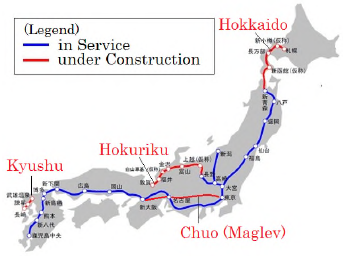
Japan Tunnelling Association is a non-profit organization with individual and corporate members.
Annual Conference on experience and investigation of tunneling in mountainous areas and in urban areas.
Workshops for Skill-up of tunnel engineers of middle standing (on conventional method tunneling/ shield method tunneling)
Big projects of tunnelling start
Japanese Government authorized the construction of the three Shinkansen extensions.
Constructions of many tunnels are planned in these extending sections because of the topographical feature of Japanese national land.
For instance, the Hokkaido Shinkansen extension (211km) has 160km of tunnels which accounts for about 76%.
The Hokuriku Shinkansen extension (114km) has 36km of tunnels (32%).
The Kyushu Shinkansen extension (67km) has 40km of tunnels (61%). The longest one will be the Oshima tunnel (26km) in the Hokkaido Shinkansen extension.
 Government also approved the construction of Chuo Shinkansen line between Tokyo and Osaka with the magnetic levitation (Maglev) system. The maximum speed is 505km/h. It will take 67 minutes from Tokyo to Osaka (150 minutes by present Tokaido Shinkansen). As the first construction stage from Tokyo to Nagoya (286km), the procedures of the environmental impact assessment are proceeding.
Government also approved the construction of Chuo Shinkansen line between Tokyo and Osaka with the magnetic levitation (Maglev) system. The maximum speed is 505km/h. It will take 67 minutes from Tokyo to Osaka (150 minutes by present Tokaido Shinkansen). As the first construction stage from Tokyo to Nagoya (286km), the procedures of the environmental impact assessment are proceeding.
Many tunnels are planned to be constructed in high mountain ranges and highly developed urban areas. In the latter regions, tunnels will be constructed under the Law of Public Use of Deep Underground.
Lots of highway tunnels are constructed in the expressway network, such as New Tomei Expressway, New Meishin Expressway, Expressways in the metropolitan areas, etc.
In Tokyo, Shinagawa Tunnel of 8.4km, a part of the Central Ring Expressway, is in the final stage of construction works. It will become one of the longest tunnels in urban areas after it connects with Yamate Tunnel (9.8km) in service.
 Another big project of the Tokyo Outer Ring Expressway has started.
Another big project of the Tokyo Outer Ring Expressway has started.
The expressway connects the trunk expressways of Tomei , Chuo and Kan-etsu Expressways in the western regsion of Tokyo.
The whole length of 16.2km is planned to be a twin tunnels with three lanes respectively to preserve the environment and surface use in this region. The tunnels will be constructed under the Law of Public Use of Deep Underground.
The tunnels have several branches for junctions and interchanges. Innovative technologies will be applied to expand the cross section of main tunnels for branches under the ground.

